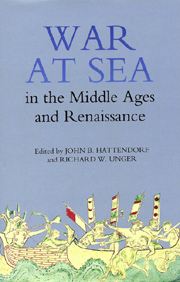Book contents
- Frontmatter
- Contents
- List of illustrations
- List of Contributors
- Preface
- Acknowledgements
- Introduction: Theories of Naval Power: A. T. Mahan and the Naval History of Medieval and Renaissance Europe
- I Northern Europe
- II Southern Europe
- III Sixteenth and Early-Seventeenth-Century Europe
- The Navies of the Medici: The Florentine Navy and the Navy of the Sacred Military Order of St Stephen, 1547–1648
- The State of Portuguese Naval Forces in the Sixteenth Century
- Naval Power in the Netherlands before the Dutch Revolt
- Naval Power and Control of the Sea in the Baltic in the Sixteenth Century
- The New Atlantic: Naval Warfare in the Sixteenth Century
- Conclusion: Toward a History of Medieval Sea Power
- Index
- Titles in the series
The State of Portuguese Naval Forces in the Sixteenth Century
from III - Sixteenth and Early-Seventeenth-Century Europe
Published online by Cambridge University Press: 05 April 2013
- Frontmatter
- Contents
- List of illustrations
- List of Contributors
- Preface
- Acknowledgements
- Introduction: Theories of Naval Power: A. T. Mahan and the Naval History of Medieval and Renaissance Europe
- I Northern Europe
- II Southern Europe
- III Sixteenth and Early-Seventeenth-Century Europe
- The Navies of the Medici: The Florentine Navy and the Navy of the Sacred Military Order of St Stephen, 1547–1648
- The State of Portuguese Naval Forces in the Sixteenth Century
- Naval Power in the Netherlands before the Dutch Revolt
- Naval Power and Control of the Sea in the Baltic in the Sixteenth Century
- The New Atlantic: Naval Warfare in the Sixteenth Century
- Conclusion: Toward a History of Medieval Sea Power
- Index
- Titles in the series
Summary
Portuguese sea-power was, in its day and for its time, immensely impressive
ALMOST every attempt made so far to provide a theoretical basis for naval power has failed to consider Portugal among the elite club of powers that, at some historical moment, could be considered global maritime powers. This exclusionary analysis dated back to Alfred Mahan and almost every subsequent essayist and historian has followed him. Nevertheless, in 1988, George Modelski and William Thompson proposed a new vision of how naval power has evolved since the end of the fifteenth century to today. They came to the conclusion that four major naval forces have appeared on a worldwide scale: Portugal, Holland, England and the United States of America. Like Mahan, Modelski and Thompson did not consider Spain to be a part of this group, because it should only be considered a regional power. Comparison between these two works immediately highlights the obviously different methodologies and criteria adopted which inevitably and, as expected, conditioned any final conclusions drawn. However, the different perspectives are also a result of factors other than just methodological criteria. The reason that led Modelski and Thompson to propose Portugal as the first major naval power in the modern period was clearly, above all, the chronological period covered by their study. In fact, specialists usually take the middle of the seventeenth century as the first moment to consider, following Mahan.
- Type
- Chapter
- Information
- War at Sea in the Middle Ages and the Renaissance , pp. 187 - 198Publisher: Boydell & BrewerPrint publication year: 2002

